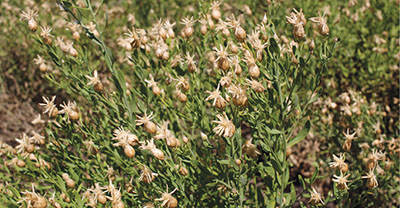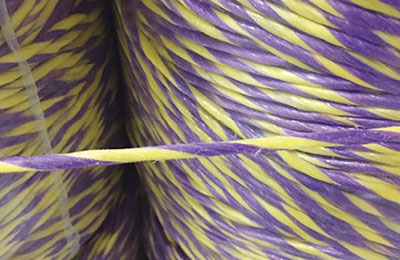Certified Noxious Weed Free Program
Guide A-145
Revised by Leslie Beck and Phillip Lujan
College of Agricultural, Consumer and Environmental Sciences, New Mexico State University
Respectively, Extension Weed Specialist and Seed Certification and Noxious Weed Free Program Manager, Department of Extension Plant Sciences, New Mexico State University. (Print Friendly PDF)
Frequently Asked Questions About Buying and Producing Certified Noxious Weed Free Products in New Mexico
What is the difference between a noxious and an invasive weed?
According to the Weed Science Society of America, a noxious weed is any plant designated by federal, state, or local government officials as injurious to public health, agriculture, recreation, wildlife, or property, and is difficult to control or eradicate. Once a weed is classified as noxious, authorities can implement quarantines and take other actions to contain or destroy the weed and limit its spread. Invasive weeds are weeds that establish, persist, and spread widely in natural ecosystems outside the plant’s native range. When in a foreign locale, these invaders often lack natural enemies to curtail their growth, enabling them to overrun native plants and ecosystems. All noxious weeds are considered to be invasive, but not all invasive weeds are classified as noxious.

(Photo of Russian knapweed by Leslie Beck.)
Does New Mexico have a list of noxious weeds?
Yes. Under the New Mexico Noxious Weed Act of 1963, the New Mexico Department of Agriculture (NMDA) was created under the control and authority of the board of regents of New Mexico State University. The Noxious Weeds Management Act directs NMDA to develop a noxious weed list for the state and update the list every few years. The current NM Noxious Weed List contains 41 weed species (see tables below), was updated in July 2020, and can be accessed at www.nmda.nmsu.edu.
|
Class A Species are currently not in NM or have limited distribution |
|
|
Black henbane |
Hyoscyamus niger |
|
Camelthorn |
Alhagi pseudalhagi |
|
Canada thistle |
Cirsium arvense |
|
Dalmatian toadflax |
Linaria dalmatica |
|
Diffuse knapweed |
Centaurea diffusa |
|
Dyer's woad |
Isatis tinctoria |
|
Giant salvinia* |
Salvinia molesta |
|
Hoary cress |
Cardaria spp. |
|
Leafy spurge |
Euphorbia esula |
|
Oxeye daisy |
Leucanthemum vulgare |
|
Purple loosestrife |
Lythrum salicaria |
|
Purple starthistle |
Centaurea calcitrapa |
|
Ravenna grass |
Saccharum ravennae |
|
Scentless chamomile |
Matricaria perforata |
|
Scotch thistle |
Onopordum acanthium |
|
Spotted knapweed |
Centaurea biebersteinii |
|
Yellow starthistle |
Centaurea solstitialis |
|
Yellow toadflax |
Linaria vulgaris |
|
Class B Species are limited to portions of the state |
|
|
African rue |
Peganum harmala |
|
Bull thistle |
Cirsium vulgare |
|
Chicory |
Cichorium intybus |
|
Halogeton |
Halogeton glomeratus |
|
Malta starthistle |
Centaurea melitensis |
|
Perennial pepperweed |
Lepidium latifolium |
|
Poison hemlock |
Conium maculatum |
|
Quackgrass |
Elytrigia repens |
|
Spiny cocklebur |
Xanthium spinosum |
|
Teasel |
Dipsacus fullonum |
|
Class C Species are widespread in the state |
|
|
Cheatgrass |
Bromus tectorum |
|
Curlyleaf pondweed |
Potamogeton crispus |
|
Eurasian watermilfoil |
Myriophyllum spicatum |
|
Giant cane |
Arundo donax |
|
Hydrilla* |
Hydrilla verticillata |
|
Jointed goatgrass |
Aegilops cylindrica |
|
Musk thistle |
Carduus nutans |
|
Parrotfeather |
Myriophyllum aquaticum |
|
Russian knapweed |
Acroptilon repens |
|
Russian olive |
Elaeagnus angustifolia |
|
Saltcedar |
Tamarix spp. |
|
Siberian elm |
Ulmus pumila |
|
Tree of heaven |
Ailanthus altissima |
Please note that only the species marked with an asterisk (*) are cross-referenced in the North American Noxious Weed list.
What does “certified noxious weed free” mean?
Certified Noxious Weed Free (CNWF) products have been inspected by New Mexico State University Seed Certification Noxious Weed Free Program (SCNWFP) trained inspectors prior to harvesting or distribution of the products. Only products found to be free of weed species listed on the North American Noxious Weed list and the New Mexico Noxious Weed list can be certified.
What is the purpose of a Certified Noxious Weed Free program?
Noxious weed-infested products, such as hay, mulches, erosion control materials, and gravel, may facilitate the introduction or spread of noxious weed species within an area. Therefore, a CNWF program is designed to promote healthy vegetative communities in roadsides, construction sites, restoration projects, agricultural fields, and open rangelands by providing certified products that are unlikely to cause noxious weed infestations, which can help prevent costly weed management actions in the future. Furthermore, as federal and state land management agencies begin to adopt noxious weed free polices, the demand for certified products will likely increase.
What can be certified?
Products that can be certified through the SCNWFP are forages, mulches, erosion control materials, and gravel pits. Products certified through this program meet minimum acceptable standards provided by the North American Weed Management Association.
In order to be certified, products like alfalfa hay and straw must be inspected at each cutting by contacting the SCNWFP at NMSU 10 days prior to harvest. Site/facility inspections for mulches, erosion control materials, and gravel pits are required annually or periodically for certification. All inspections require a cost on a per acre basis, and twine or tags must be purchased through the SCNWFP. Please visit https://seedcertification.nmsu.edu for additional information on costs.
Who can certify your product?
Only an inspector of the NMSU SCNWFP can certify your product as noxious weed free. Products certified through the program meet minimum acceptable standards provided by the North American Invasive Species Management Association (NAISMA). The NMSU SCNWFP is the only agency under NAISMA and NMDA in New Mexico that can conduct the certifications and issue certificates and tags.
Is this program mandatory for producers?
No, this program is not mandatory for producers. Requests and inspections are made solely on a voluntary basis.
What documents are required to get started?
To request an inspection, the required documents are available by contacting seedcert@nmsu.edu. Forms can be obtained at https://seedcertification.nmsu.edu, or by mailing a request to NMSU Seed Certification Noxious Weed Free Program, Leyendecker Research Center, P.O. Box 30003, MSC 3LEY, Las Cruces, NM 88003-8003. Forms can be mailed to this address or scanned and emailed to seedcert@nmsu.edu.
What should I expect for the inspection?
When requesting an inspection, be prepared to have an inspector arrive and assess your fields and/or operating facility for the presence of plant species listed on the North American and New Mexico Noxious Weed lists. For a forage inspection, the inspector will be using various inspection patterns depending on the field shape and size. If requesting a site inspection for mulches, erosion control materials, or gravel pits, the inspector will be inspecting all areas of the site to ensure that no noxious plant species are present.

Figure 1. Special twine attached to certain noxious weed free products, usually hay/straw.
After the forage or site inspection is completed, the inspector will provide you with a copy of the Inspection Certificate. Transit Certificates are also offered for out-of-state shipping of the certified products. The special twine (Figure 1) and/or labels (Figure 2) provided at the time of inspection are considered, in most cases, as proof of certification of the products within the state. At least one strand of the special twine must be placed on each bale of certified hay/straw.

Figure 2. Sample certified noxious weed free label.
What does certification NOT guarantee?
- It does not guarantee a complete absence of noxious weeds. It only certifies that the inspector made a reasonable and prudent visual inspection and did not find any noxious weed species.
- It does not certify quality, protein content, maturity, or safety of the product.
- It does not mean that there is an absence of non-noxious weeds in the product. The inspector may note on the inspection certificate other factors, such as non-noxious weeds.
- Certification under these rules does not qualify a commodity for export from the United States.
For Further Reading
A-131: Certified Seed
pubs.nmsu.edu/_a/A131/
A-616: Herbicide Resistance: Development and Management
pubs.nmsu.edu/_a/A616/
CR-666: Organic Good Agricultural Practices for New Mexico
pubs.nmsu.edu/_circulars/CR666/
Original authors: Michelle Cattaneo, NMSU Seed Certification Technician III; Jamshid Ashigh, Extension Weed Specialist/Assistant Professor; and Tracey Carrillo, Assistant Director, Campus Farm Operations.

Leslie Beck is the Extension Weed Specialist at New Mexico State University. Her research program focuses on integrated weed management systems in landscape, horticultural, and agronomic crops. Her Extension work provides the citizens of New Mexico with accurate, applicable, and effective weed identification and management strategies in multiple cropping systems.
To find more resources for your business, home, or family, visit the College of Agricultural, Consumer and Environmental Sciences on the World Wide Web at pubs.nmsu.edu.
Contents of publications may be freely reproduced, with an appropriate citation, for educational purposes. All other rights reserved. For permission to use publications for other purposes, contact pubs@nmsu.edu or the authors listed on the publication.
New Mexico State University is an equal opportunity/affirmative action employer and educator. NMSU and the U.S. Department of Agriculture cooperating.
Revised June 2021 Las Cruces, NM


